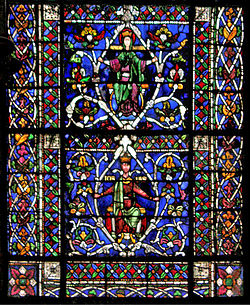Detail of a Tree of Jesse Window from Canterbury Cathedral (late 12th–early 13th c.) | |
| Years active | 12th to 17th century |
|---|---|
| Location | England |
English Gothic stained glass windows were an important feature of English Gothic architecture, which appeared between the late 12th and late 16th centuries. They evolved from narrow windows filled with a mosaic of deeply-coloured pieces of glass into gigantic windows that filled entire walls, with a full range of colours and more naturalistic figures. In later windows, the figures were often coloured with silver stain, enamel paints and flashed glass. Later windows used large areas of white glass, or grisaille, to bring more light into the interiors.
English Gothic windows followed roughly the same evolution of styles as English architecture: they followed windows in the Norman or Romanesque style, beginning in the late 12th century. somewhat later than in France. In the 13th century, the Decorated style appeared, which was divided into two periods: the later being the more ornate curvilinear. The next and last period was the Perpendicular Gothic, which lasted well into the 16th century, longer than in continental Europe.
Much of the original glass was destroyed in the English Reformation and has been replaced with modern work. However, examples of original glass are found in Canterbury Cathedral, Wells Cathedral, York Minster and Westminster Abbey.
